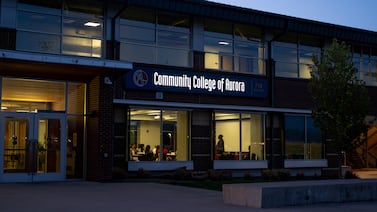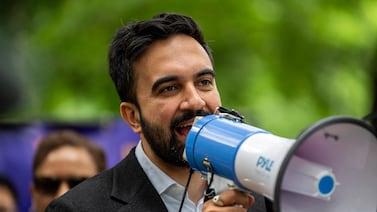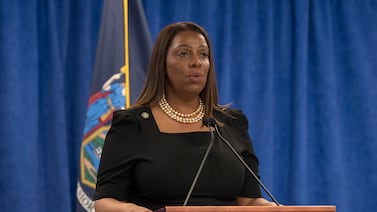In the thick of the pandemic, Molly Beth Jourdan, a science teacher at Kenwood Academy High School on Chicago’s South Side, started an arduous two-year quest for the “gold standard” in her profession: certification by the National Board for Professional Teaching Standards.
She spent hundreds of extra hours reviewing footage of her own teaching, reflecting on ways she could improve, and parsing data on how her students were doing. The work paid off for her 10th graders, she said. By February this year, they had covered three more months of chemistry than she used to teach in a typical year.
Jourdan was one of a class of 49 newly National Board certified teachers recently feted by district and teachers union leaders, who noted research linking the certification program to better learning outcomes for students.
But a Chalkbeat analysis found the overall number of board-certified teachers has decreased steadily, even as the number of educators Chicago Public Schools employs has grown. About 1,000 of the district’s more than 22,000 educators are board-certified, down almost 30% since 2016.
Last school year, about 170 of the district’s 500-some campuses did not employ any certified teachers, up from roughly 120 in 2016 — most of them schools serving predominantly Black students.
The reasons for that decrease are not entirely clear, but likely involve a tangle of factors, officials say. Those include a shift years ago to a lengthier certification process that briefly dampened certifications, COVID’s disruption more recently and some certified teachers leaving their posts — both for leadership roles in the district and for jobs in other districts.
Still, district and teachers union leaders say a longstanding partnership on board certification remains strong — and they share a goal of cultivating more certified educators in the coming years. The district said in a statement it plans to step up outreach to teachers to promote board certification, especially among teachers of color and other underrepresented groups.
“That should be our goal — to lead the nation,” said school board president Miguel del Valle during the March board meeting, “and I think we can get there.”
He added, “I can’t think of a better way to spend our dollars than to help teachers develop to the point where they are the gold standard.”
Tamara Poulson, a spokeswoman for the National Board, said Chicago came in fifth nationally based on the number of new certifications. The Chicago Teachers Union says the district is third for overall certified teachers, data the board said it does not publicize.
Poulson said the start of the pandemic disrupted the certification process. But nationally, the overall number of board-certified teachers has continued to grow to more than 133,000 by latest count, and the number of new certifications has rebounded, with a record pool of 2023 candidates.
Some studies have shown that the students of board-certified teachers learn more than their peers in other classrooms on average. One mid-2010s National Board-funded study by CNA, a nonprofit research organization based in the Washington D.C. area, looked at outcomes for students in Chicago Public Schools and rural districts in Kentucky and found board-certified educators made a difference for students across subjects and types of schools.
But Dan Goldhaber, the director of the Center for Education Data & Research at the University of Washington, who has studied board certification, said the evidence is not conclusive on whether board certification itself actually builds better teachers. There is strong evidence, however, that the process is powerful at identifying and empowering the most talented educators.
Number of board-certified teachers in Chicago shrinks
Amid a push in the 2010s to evaluate and pay teachers based on performance, a growing number of districts and states offered board-certified teachers pay incentives. Those incentives, along with the growing research on the program and student outcomes, powered steep increases in newly certified teachers. That enthusiasm has cooled off somewhat, Goldhaber said, and some states have done away with compensation incentives.
Not Chicago, where certified educators in the district get a $2,295 annual stipend. In keeping with the union contract, the district pays $750,000 a year to support the Chicago Teachers Union’s “Nurturing Teacher Leadership” program that helps educators attain certification and covers all their expenses.
Proposed legislation in Illinois would give retention bonuses of $4,000 per year for two years to board-certified teachers working in hard-to-staff schools.
In keeping with the national trend, Chicago’s board-certified teacher ranks had swelled rapidly earlier in the 2010s, but the rise has slowed more recently. Few new teachers got certified in the 2016 and 2017 fiscal years amid changes that made the process lengthier. Except for a dip in 2019, 50-some teachers a year have gotten certified in recent years.
Meanwhile, ensuring schools with the highest student needs have board-certified teachers on staff has remained a challenge.
Majority Black schools made up about 65% of campuses with no board-certified teachers on staff last year. Among schools that do employ at least one certified teacher, the student-to-board-certified-teacher ratio is highest in schools that serve predominantly Latino students and lowest in the relatively small number of schools where white students are the largest racial group.
Not surprisingly, the district’s selective enrollment high schools topped the list of campuses with the largest clusters of board-certified teachers, leading with Whitney Young with 25 such teachers. But Curie Metropolitan High, a high-poverty campus on the Southwest Side, came in fifth with 18 board-certified educators, outranking some test-in schools. Back of the Yards High School, also on the Southwest Side, has also cultivated a growing cluster in recent years. Among elementary schools, Ogden, Coonley, and Peirce — all on the North Side — have the most certified teachers.
Lynn Cherkasky-Davis, who leads the CTU’s certification program, said some board-certified teachers have been promoted to assistant principal, principal, and central office positions — and that’s a good thing: “They are still supporting our teachers and our students.”
Some likely have left the district; COVID brought an uptick in educator resignations and retirements after years of steep decreases in teacher departures from the district. To keep more of these educators, she said, the district should consider upping incentives for certified teachers.
Cherkasky-Davis noted that over the years, the CTU’s program has come to work with fewer certification candidates but it also better ensures that they are prepared for the enormous time and effort involved. As a result, 94% of district teachers who attempt certification succeed, compared to a national average of 70%. That probably means that fewer Chicago teachers ultimately get certified — but also fewer attempt the process unsuccessfully.
Educators praise board certification for helping them improve
At a celebration during the March school board meeting, district and union officials recognized the 49 newly certified educators, 45% of whom are of color. Another 103 teachers, counselors, and librarians recently renewed their certification.
The event brought a rare moment of mutual appreciation between district and teachers union leaders. CTU president Stacy Davis Gates called the certification efforts “a great demonstration of collaboration and cooperation,” noting the program is special to her because the late union president Karen Lewis was a board-certified teacher.
Sharon Coleman, a counselor at Wendell Smith Elementary on the South Side, became one of 18 district counselors, or 2% of all counselors in Chicago Public Schools, to get board certified. She said the certification process taught her how to better track and crunch data on her students. That helped her realize they needed more guidance in choosing high schools to apply to, so she created a selection chart to help them figure out what campuses were the best fit. Certification also propelled her into school and district leadership roles.
“I wanted to improve the well-being of students in my school community,” she told the school board, noting she was also eager to help increase the number of board-certified counselors of color.
Israel Perez, the principal at Yates Elementary on the Northwest Side, said the process of becoming board-certified a decade ago was the most helpful professional development he ever got. Certification cleared the way for him to make the transition from classroom teacher to school leader.
He renewed his certification this school year, spending weeks teaching fifth-grade math — an experience that helped him reconnect to the classroom and better understand the needs of students and teachers in his building.
Perez said he is forming a group of teachers at Yates to pursue board certification together — and has asked the district to offer the board certification stipend to principals as well.
Cherkasky-Davis told the board roughly 15% of the new class of certified teachers work with students with disabilities, and about 17% are STEM educators. All in all, almost 40% of all certified teachers in the district now are educators of color.
She is pleased with the numbers, she said, but “there’s still work to be done.”
Mila Koumpilova is Chalkbeat Chicago’s senior reporter covering Chicago Public Schools. Contact Mila at mkoumpilova@chalkbeat.org.






